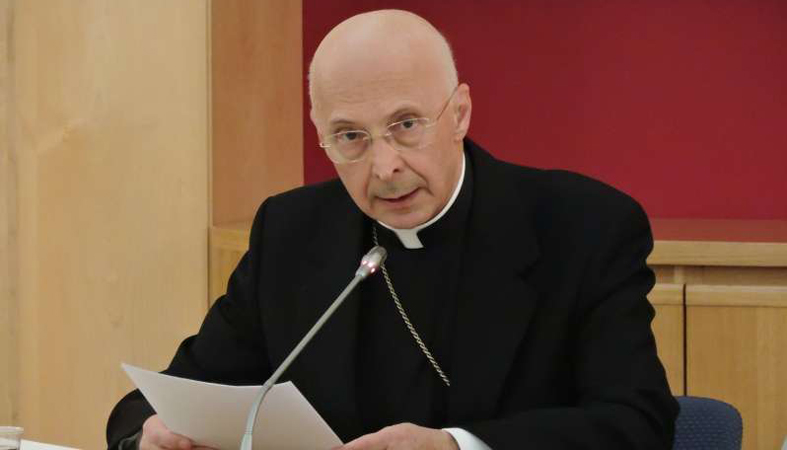
Cardinale Angelo Bagnasco : Omelia alla Sagrada Família
Cari Confratelli nell’Episcopato e nel Sacerdozio Cari Fratelli e Sorelle nel Signore Cari Amici È...
0 +41 71 227 6040
+41 71 227 6040
 ccee@ccee.eu
ccee@ccee.eu

Throughout the ages, the Church has had a special concern for beauty, art, architecture, and liturgy, for these are very powerful ways of accompanying people on their path of faith. The very concept of faith is that it goes beyond the concrete, visible reality of every day. Man has been created with a will, intellect and soul, taught Saint Thomas. All of these need to be addressed if we wish to help people advance in their understanding of God. In this context, the word “understanding” goes beyond the purely intellectual, involving also our more emotive side. Words alone, or intellectual logic alone, or heartwarming experiences alone are not enough to grasp something of the very being of God. On the one hand, God cannot be fully explained and described using our intellect in logical reasoning. He always remains an ineffable mystery to us, for God is always greater, as Saint Anselm reminded us. On the other hand, there are ways in which we can approach the very heart of that mystery. In doing so, we advance on our path of faith towards God.
Beauty, art, architecture, and liturgy, are not just poetry for the illiterate. They are powerful ways in which the presence and essence of God is expressed and experienced, whilst letting him be the ultimately ineffable being he is. In this sense, they are also powerful “tools” for those responsible for the accompaniment of people. This includes young people of today, for although the number of visits to museums and the theatre may be in decline, beauty, art, architecture and even liturgy speak a powerful language that can be understood without much prior explanation. These “tools’ speak on their own: they are there to be experienced and thus help the person to advance on their path with God. This corresponds with an important element of accompaniment, where the person who is accompanying needs to withdraw from time to time, and ‘let the Creator deal directly with the creature’, as Saint Ignatius of Loyola said. Obviously, this does not mean that the one accompanying needs only to walk behind, and respond to what is experienced. There are times where a clear lead is needed. Accompaniment means also spiritual guidance in the sense of helping to see beyond, of walking ahead where necessary. When young people are given just a few key elements to better read and understand beauty, art, architecture, and liturgy, they can better appreciate their deeper message, and let these “tools” help them to draw nearer to the mystery of God.
Liturgy has a bridge function between man and God. Whilst the form of the liturgy is of human making, its essence comes directly from God. For example, the way we celebrate the Eucharist is the product of a development throughout the ages, but the essence of what Jesus told his disciples to do in memory of himself never changed. The liturgy is a precious moment where heaven and earth momentarily come very close, as powerfully expressed in the singing of the Sanctus. The liturgy speaks to all the human senses: for example the hearing of words and music, the smelling of incense and perfumed oil, the sight of beauty and symbols, the touching and kissing of the cross or relics, the taste of bread and wine. The liturgy addresses the entirety of our human being, just as we have been created by God. He knows better than we what we need and what is important in our lives. In the liturgy, art and architecture play their highest role: here the ideas they transpire are funneled towards one single message, the love of God for every human being and his desire that they all will respond positively to his invitation.
In his design for the basilica of the Sagrada Família, the Spanish architect Antoni Gaudí intended to create a building that would both bring honour to God in every detail, and at the same time express the grandeur of his loving plan of salvation to all who visited it. In doing so, Gaudì created a monumental structure of evangelization. Being a devout Christian himself, he wished for others to encounter the love of God and he intended his work to contribute to this. So, even today, the tourist looking up at one of the towers of the basilica inadvertently praises God when they read the letters “Sanctus, Sanctus”. The visitor who takes time to contemplate one of the facades, will recognise that the story it tells goes beyond his or her experience on earth. And whoever enters the nave, will be struck by the light, the organic forms, the grandeur, and the natural way in which the eye is led towards the central place in this building, which is the altar space where the liturgy is celebrated. The strongest way in which beauty, art, and architecture come together in this masterwork of Gaudí is when participating in one of the great liturgies celebrated in the basilica. At that moment all comes together: whilst each of the senses is being addressed and helps to recognise the presence of God, the architecture as a whole points in only one direction, that of the love of God himself. In this sense, the basilica of the Sagrada Família is a great example of how beauty, art, architecture, and liturgy can be powerful allies in the accompaniment of young people today on their path with God.